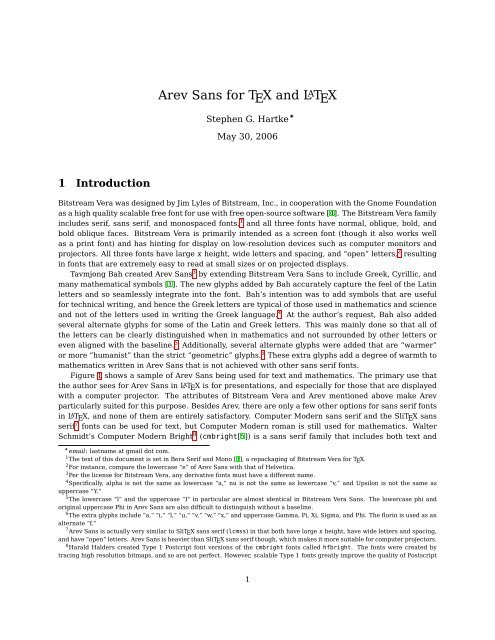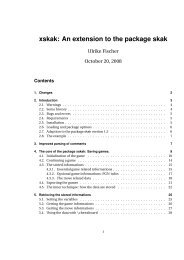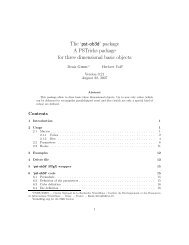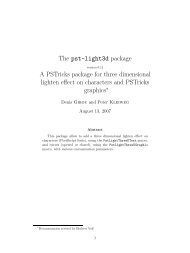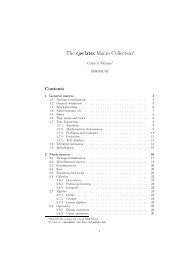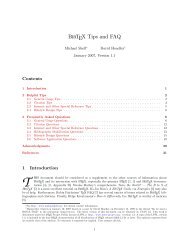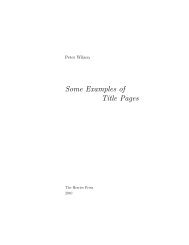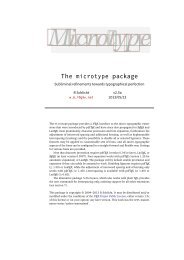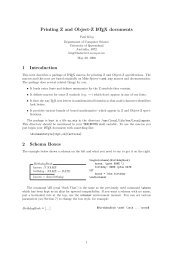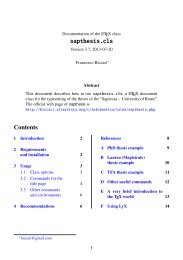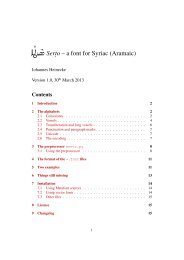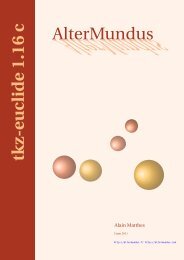Arev Sans for TeX and LaTeX
Arev Sans for TeX and LaTeX
Arev Sans for TeX and LaTeX
You also want an ePaper? Increase the reach of your titles
YUMPU automatically turns print PDFs into web optimized ePapers that Google loves.
<strong>Arev</strong> <strong>Sans</strong> <strong>for</strong> T E X <strong>and</strong> L A T E X<br />
Stephen G. Hartke ∗<br />
May 30, 2006<br />
1 Introduction<br />
Bitstream Vera was designed by Jim Lyles of Bitstream, Inc., in cooperation with the Gnome Foundation<br />
as a high quality scalable free font <strong>for</strong> use with free open-source software [4]. The Bitstream Vera family<br />
includes serif, sans serif, <strong>and</strong> monospaced fonts, 1 <strong>and</strong> all three fonts have normal, oblique, bold, <strong>and</strong><br />
bold oblique faces. Bitstream Vera is primarily intended as a screen font (though it also works well<br />
as a print font) <strong>and</strong> has hinting <strong>for</strong> display on low-resolution devices such as computer monitors <strong>and</strong><br />
projectors. All three fonts have large x height, wide letters <strong>and</strong> spacing, <strong>and</strong> “open” letters, 2 resulting<br />
in fonts that are extremely easy to read at small sizes or on projected displays.<br />
Tavmjong Bah created <strong>Arev</strong> <strong>Sans</strong> 3 by extending Bitstream Vera <strong>Sans</strong> to include Greek, Cyrillic, <strong>and</strong><br />
many mathematical symbols [1]. The new glyphs added by Bah accurately capture the feel of the Latin<br />
letters <strong>and</strong> so seamlessly integrate into the font. Bah’s intention was to add symbols that are useful<br />
<strong>for</strong> technical writing, <strong>and</strong> hence the Greek letters are typical of those used in mathematics <strong>and</strong> science<br />
<strong>and</strong> not of the letters used in writing the Greek language. 4 At the author’s request, Bah also added<br />
several alternate glyphs <strong>for</strong> some of the Latin <strong>and</strong> Greek letters. This was mainly done so that all of<br />
the letters can be clearly distinguished when in mathematics <strong>and</strong> not surrounded by other letters or<br />
even aligned with the baseline. 5 Additionally, several alternate glyphs were added that are “warmer”<br />
or more “humanist” than the strict “geometric” glyphs. 6 These extra glyphs add a degree of warmth to<br />
mathematics written in <strong>Arev</strong> <strong>Sans</strong> that is not achieved with other sans serif fonts.<br />
Figure 1 shows a sample of <strong>Arev</strong> <strong>Sans</strong> being used <strong>for</strong> text <strong>and</strong> mathematics. The primary use that<br />
the author sees <strong>for</strong> <strong>Arev</strong> <strong>Sans</strong> in LAT E X is <strong>for</strong> presentations, <strong>and</strong> especially <strong>for</strong> those that are displayed<br />
with a computer projector. The attributes of Bitstream Vera <strong>and</strong> <strong>Arev</strong> mentioned above make <strong>Arev</strong><br />
particularly suited <strong>for</strong> this purpose. Besides <strong>Arev</strong>, there are only a few other options <strong>for</strong> sans serif fonts<br />
in LAT E X, <strong>and</strong> none of them are entirely satisfactory. Computer Modern sans serif <strong>and</strong> the SliT E X sans<br />
serif 7 fonts can be used <strong>for</strong> text, but Computer Modern roman is still used <strong>for</strong> mathematics. Walter<br />
Schmidt’s Computer Modern Bright 8 (cmbright[5]) is a sans serif family that includes both text <strong>and</strong><br />
∗ email : lastname at gmail dot com.<br />
1 The text of this document is set in Bera Serif <strong>and</strong> Mono [3], a repackaging of Bitstream Vera <strong>for</strong> T E X.<br />
2 For instance, compare the lowercase “e” of <strong>Arev</strong> <strong>Sans</strong> with that of Helvetica.<br />
3 Per the license <strong>for</strong> Bitstream Vera, any derivative fonts must have a different name.<br />
4 Specifically, alpha is not the same as lowercase “a,” nu is not the same as lowercase “v,” <strong>and</strong> Upsilon is not the same as<br />
uppercase “Y.”<br />
5 The lowercase “l” <strong>and</strong> the uppercase “I” in particular are almost identical in Bitstream Vera <strong>Sans</strong>. The lowercase phi <strong>and</strong><br />
original uppercase Phi in <strong>Arev</strong> <strong>Sans</strong> are also difficult to distinguish without a baseline.<br />
6 The extra glyphs include “a,” “i,” “l,” “u,” “v,” “w,” “x,” <strong>and</strong> uppercase Gamma, Pi, Xi, Sigma, <strong>and</strong> Phi. The florin is used as an<br />
alternate “f.”<br />
7 <strong>Arev</strong> <strong>Sans</strong> is actually very similar to SliT E X sans serif (lcmss) in that both have large x height, have wide letters <strong>and</strong> spacing,<br />
<strong>and</strong> have “open” letters. <strong>Arev</strong> <strong>Sans</strong> is heavier than SliT E X sans serif though, which makes it more suitable <strong>for</strong> computer projectors.<br />
8 Harald Halders created Type 1 Postcript font versions of the cmbright fonts called hfbright. The fonts were created by<br />
tracing high resolution bitmaps, <strong>and</strong> so are not perfect. However, scalable Type 1 fonts greatly improve the quality of Postscript<br />
1
Theorem 1 (Residue Theorem). Let ƒ be analytic in the region G except <strong>for</strong> the isolated<br />
singularities 1 , 2 , . . . , m . If γ is a closed rectifiable curve in G which does not<br />
pass throughany of the points k <strong>and</strong> if γ≈0 in G then<br />
1<br />
2π<br />
∫<br />
ƒ=<br />
γ<br />
m∑<br />
n(γ; k )Res(ƒ ; k ).<br />
k=1<br />
Another nice theorem from complex analysis is<br />
Theorem 2 (MaximumModulus). Let G be a boundedopensetinC<strong>and</strong>supposethat<br />
ƒ is a continuousfunctionon G − which is analyticin G. Then<br />
mx{|ƒ(z)| : z∈G − }=mx{|ƒ(z)| : z∈∂G}.<br />
ABCDEFGHJKLMNOPQRSTUVWXYZ ABCDEFGHJKLMNOPQRSTUVWXYZ<br />
abcdðefghijklmnopqrstuvwxyz bcdeƒ ghħιjȷkmnopqrstyz l℘ℵ∞ ∝ ∅∇∂<br />
ΔΘΛϒΨΩ℧ αβϐγδεϵζηθϑικϰλμνξoπϖρϱσςτυϕφχψω 01234567890<br />
Figure 1: Font sample of <strong>Arev</strong> <strong>Sans</strong> text <strong>and</strong> math.<br />
mathematics, but is very thin <strong>and</strong> does not display well on a computer projector. Kerkis <strong>Sans</strong>[9] is<br />
based on Avant Garde <strong>and</strong> includes Greek sans serif glyphs, but is also very thin. Helvetica <strong>and</strong> other<br />
PostScript sans serif fonts can be used <strong>for</strong> text <strong>and</strong> <strong>for</strong> Latin letters in mathematics, but they do not<br />
have matching Greek letters or the proper weight <strong>for</strong> geometric mathematical symbols.<br />
The arev package works well with the LAT E X package beamer [2] with the professionalfonts option.<br />
Figures 8-13 show examples of beamer with the font options mentioned above where each slide<br />
is scaled to 90% of its default size, <strong>and</strong> Figures 2-7 show side-by-side examples scaled to 50%. SliT E X<br />
sans serif is loaded into beamer using T E XPower’s tpslifonts.sty [14].<br />
2 Implementation<br />
With internationalization of computer software <strong>and</strong> the growing use of Unicode, many free scalable<br />
fonts are available that include both Latin <strong>and</strong> Greek letters. However, making use of these fonts <strong>for</strong><br />
mathematics in LAT E X is a nontrivial task: not only are there many subtleties to using fonts in LAT E X,<br />
but the documentation is scattered among many sources <strong>and</strong> there are few examples to consult. The<br />
author hopes that the arev package can serve as a template <strong>for</strong> others who wish to create new math<br />
font packages <strong>for</strong> LAT E X.<br />
The excellent GPLed font editor FontForge [6] was used by Bah to create <strong>Arev</strong> <strong>Sans</strong> <strong>and</strong> was used<br />
by the author <strong>for</strong> creating PostScript pfb, afm , <strong>and</strong> T E X tfm files. Version 0.21a of <strong>Arev</strong> <strong>Sans</strong> contains a<br />
considerable number of glyphs; fontinst exhausted T E X’s memory trying to process the afm files. Thus,<br />
when creating the Type 1 versions of <strong>Arev</strong> <strong>Sans</strong>, most of the glyphs unused by T E X were removed. The<br />
Bash shell script afmtoglyphlist was used to extract the glyph names from the afm file into a list that<br />
a fontinst script used <strong>for</strong> renaming glyphs. The magic of fontinst was used to create virtual fonts<br />
<strong>and</strong> font metrics, LAT E X font definition files, <strong>and</strong> the dvips map file.<br />
<strong>and</strong> .pdf files on computer screens <strong>and</strong> projectors.<br />
2
Characterization of the Imaginary Forms<br />
Theorem.<br />
Let S={1,2,...,k} be a set of vectors inR n .<br />
ConsiderF(S)= ∑ k<br />
=1 δ(j)σ,j.<br />
IfF(S)≤ϵ, then<br />
<br />
ϕ(S,α)= 1 ∫ 753 ˜Wn(γ) cos<br />
2 <br />
α 2 <br />
d=det<br />
2π −∞ ƒ ′ ()R/ ω ⊗y<br />
Characterization of the Imaginary Forms<br />
Theorem.<br />
Let S = {v1, v2,...,vk } be a set of vectors in R n .<br />
Consider F(S) = ∑ k<br />
i=1 δ(v iv j w)σ i,j .<br />
If F(S) ≤ ε, then<br />
φ(S,α) = 1 ∫ 753<br />
2πi −∞<br />
(√ )<br />
˜Wn(γ) cos x 2<br />
f ′ (x)R/a<br />
( ) α 2 Π<br />
dx = det<br />
ω x ⊗ y<br />
Note: If β∈, then the <strong>for</strong>m is undefined at the points<br />
in S∩ , <strong>and</strong> the integral (1) diverges as ϵ→0. This<br />
pathological behavior can be h<strong>and</strong>led by taking ⊆S.<br />
Note: If β ∈ Γ, then the <strong>for</strong>m is undefined at the points in S ∩ Γ,<br />
<strong>and</strong> the integral I l (i1) diverges as ε → 0. This pathological<br />
behavior can be h<strong>and</strong>led by taking Γ ⊆ S.<br />
Figure 2: <strong>Arev</strong> <strong>Sans</strong><br />
Figure 3: Helvetica<br />
Characterization of the Imaginary Forms<br />
Theorem.<br />
Let S = {v1,v2, . . . ,vk} be a set of vectors in R n .<br />
Consider F(S) = P k<br />
i=1 δ(vivjw)σi,j.<br />
If F(S) ≤ ε, then<br />
φ(S, α) = 1 Z 753<br />
2πi −∞<br />
“√ ”<br />
˜Wn(γ) cos x 2<br />
f ′ (x)R/a<br />
„ « α 2 Π<br />
dx = det<br />
ω x ⊗ y<br />
Characterization of the Imaginary Forms<br />
Theorem.<br />
Let S = {v1, v2,...,vk} be a set of vectors in R n .<br />
Consider F(S) = ∑ k<br />
i=1 δ(vivjw)σi,j.<br />
If F(S) ≤ ε, then<br />
(√ )<br />
φ(S,α) = 1 ∫ 753 ˜Wn(γ) cos x 2 ( ) α 2 Π<br />
2πi −∞ f ′ dx = det<br />
(x)R/a<br />
ω x ⊗ y<br />
Note: If β ∈ Γ, then the <strong>for</strong>m is undefined at the points<br />
in S ∩ Γ, <strong>and</strong> the integral Il(i1) diverges as ε → 0. This<br />
pathological behavior can be h<strong>and</strong>led by taking Γ ⊆ S.<br />
Note: If β ∈ Γ, then the <strong>for</strong>m is undefined at the points in S ∩ Γ, <strong>and</strong> the<br />
integral Il(i1) diverges as ε → 0. This pathological behavior can be<br />
h<strong>and</strong>led by taking Γ ⊆ S.<br />
Figure 4: SliT E X font (lcmss)<br />
Figure 5: Kerkis <strong>Sans</strong><br />
Characterization of the Imaginary Forms<br />
Theorem.<br />
Let S = {v1,v2,...,vk} be a set of vectors in R n .<br />
Consider F(S) = ∑ k<br />
i=1 δ(vivjw)σi,j.<br />
If F(S) ≤ ε, then<br />
φ(S,α) = 1 ∫ 753<br />
2πi −∞<br />
(√ )<br />
˜Wn(γ)cos x 2<br />
f ′ (x)R/a<br />
( ) α 2 Π<br />
dx = det<br />
ω x ⊗ y<br />
CharacterizationoftheImaginaryForms<br />
Theorem.<br />
LetS={v1,v2,...,vk} be a set of vectors inR n .<br />
ConsiderF(S) = ∑ k<br />
i=1 δ(vivjw)σi,j.<br />
IfF(S)≤ε, then<br />
φ(S,α) = 1 ∫ 753<br />
2πi −∞<br />
( √x )<br />
˜Wn(γ) cos 2<br />
f ′ (x)R/a<br />
( ) α 2 Π<br />
dx = det<br />
ω x⊗y<br />
Note: If β ∈ Γ, then the <strong>for</strong>m is undefined at the points in S ∩ Γ,<br />
<strong>and</strong> the integral Il(i1) diverges as ε → 0. This pathological<br />
behavior can be h<strong>and</strong>led by taking Γ ⊆ S.<br />
Note: Ifβ∈Γ , then the <strong>for</strong>m is undefined at the points inS∩Γ ,<br />
<strong>and</strong> the integralIl(i1) diverges asε→0. This pathological<br />
behavior can be h<strong>and</strong>led by takingΓ⊆S.<br />
Figure 6: Computer Modern sans serif (cmss)<br />
Figure 7: CM Bright<br />
3
Characterization of the Imaginary Forms<br />
Theorem.<br />
Let S={ 1 , 2 ,..., k } be a set of vectors inR n .<br />
ConsiderF(S)= ∑ k<br />
=1 δ( j )σ ,j .<br />
IfF(S)≤ϵ, then<br />
ϕ(S,α)= 1<br />
2π<br />
∫ 753<br />
−∞<br />
<br />
˜W n (γ) cos<br />
2<br />
ƒ ′ ()R/<br />
<br />
α<br />
2<br />
d=det<br />
<br />
ω ⊗y<br />
<br />
Note: If β∈, then the <strong>for</strong>m is undefined at the points<br />
in S∩ , <strong>and</strong> the integral ( 1 ) diverges as ϵ→0. This<br />
pathological behavior can be h<strong>and</strong>led by taking ⊆S.<br />
Figure 8: <strong>Arev</strong> <strong>Sans</strong><br />
Characterization of the Imaginary Forms<br />
Theorem.<br />
Let S = {v 1 ,v 2 , . . . ,v k } be a set of vectors in R n .<br />
Consider F(S) = P k<br />
i=1 δ(v iv j w)σ i,j .<br />
If F(S) ≤ ε, then<br />
φ(S, α) = 1 Z 753<br />
2πi −∞<br />
“√ ”<br />
˜W n (γ) cos x 2<br />
„ α<br />
2<br />
Π<br />
dx = det<br />
f ′ (x)R/a<br />
ω x ⊗ y<br />
«<br />
Note: If β ∈ Γ, then the <strong>for</strong>m is undefined at the points<br />
in S ∩ Γ, <strong>and</strong> the integral I l (i 1 ) diverges as ε → 0. This<br />
pathological behavior can be h<strong>and</strong>led by taking Γ ⊆ S.<br />
Figure 9: SliT E X font (lcmss)<br />
4
Characterization of the Imaginary Forms<br />
Theorem.<br />
Let S = {v 1 ,v 2 ,...,v k } be a set of vectors in R n .<br />
Consider F(S) = ∑ k<br />
i=1 δ(v iv j w)σ i,j .<br />
If F(S) ≤ ε, then<br />
φ(S,α) = 1 ∫ 753<br />
2πi −∞<br />
(√ )<br />
˜W n (γ)cos x 2 ( α<br />
2<br />
Π<br />
f ′ dx = det<br />
(x)R/a<br />
ω x ⊗ y<br />
)<br />
Note: If β ∈ Γ, then the <strong>for</strong>m is undefined at the points in S ∩ Γ,<br />
<strong>and</strong> the integral I l (i 1 ) diverges as ε → 0. This pathological<br />
behavior can be h<strong>and</strong>led by taking Γ ⊆ S.<br />
Figure 10: Computer Modern sans serif (cmss)<br />
CharacterizationoftheImaginaryForms<br />
Theorem.<br />
LetS={v 1 ,v 2 ,...,v k } be a set of vectors inR n .<br />
ConsiderF(S) = ∑ k<br />
i=1 δ(v iv j w)σ i,j .<br />
IfF(S)≤ε, then<br />
φ(S,α) = 1 ∫ 753<br />
2πi −∞<br />
( √x )<br />
˜W n (γ) cos<br />
2 ( α<br />
2<br />
Π<br />
f ′ dx = det<br />
(x)R/a ω x⊗y<br />
)<br />
Note: Ifβ∈Γ , then the <strong>for</strong>m is undefined at the points inS∩Γ ,<br />
<strong>and</strong> the integralI l (i 1 ) diverges asε→0. This pathological<br />
behavior can be h<strong>and</strong>led by takingΓ⊆S.<br />
Figure 11: CM Bright<br />
5
Characterization of the Imaginary Forms<br />
Theorem.<br />
Let S = {v 1 , v 2 ,...,v k } be a set of vectors in R n .<br />
Consider F(S) = ∑ k<br />
i=1 δ(v iv j w)σ i,j .<br />
If F(S) ≤ ε, then<br />
φ(S,α) = 1 ∫ 753<br />
2πi −∞<br />
(√ )<br />
˜W n (γ) cos x<br />
2 ( α<br />
2<br />
Π<br />
f ′ dx = det<br />
(x)R/a<br />
ω x ⊗ y<br />
)<br />
Note: If β ∈ Γ, then the <strong>for</strong>m is undefined at the points in S ∩ Γ, <strong>and</strong> the<br />
integral I l (i 1 ) diverges as ε → 0. This pathological behavior can be<br />
h<strong>and</strong>led by taking Γ ⊆ S.<br />
Figure 12: Kerkis <strong>Sans</strong><br />
Characterization of the Imaginary Forms<br />
Theorem.<br />
Let S = {v 1 , v 2 ,...,v k } be a set of vectors in R n .<br />
Consider F(S) = ∑ k<br />
i=1 δ(v iv j w)σ i,j .<br />
If F(S) ≤ ε, then<br />
φ(S,α) = 1 ∫ 753<br />
2πi −∞<br />
(√ )<br />
˜W n (γ) cos x 2 ( α<br />
2<br />
Π<br />
f ′ dx = det<br />
(x)R/a<br />
ω x ⊗ y<br />
)<br />
Note: If β ∈ Γ, then the <strong>for</strong>m is undefined at the points in S ∩ Γ,<br />
<strong>and</strong> the integral I l (i 1 ) diverges as ε → 0. This pathological<br />
behavior can be h<strong>and</strong>led by taking Γ ⊆ S.<br />
Figure 13: Helvetica<br />
6
The vertical placement of math accents requires the accents to be appropriately placed <strong>for</strong> characters<br />
1 ex high. The accents also need to have a zero depth, which is set by the file fixot1accents.mtx<br />
(based on their bounding boxes, the accents naturally have negative depths). Horizontal placement of<br />
math accents is done by centering the accent over the character, <strong>and</strong> then adjusting the position by the<br />
kern between the character on the left <strong>and</strong> a special character called the skewchar. Bah has accent<br />
placement in<strong>for</strong>mation in his FontForge sfd files, so the scripts createkerndata, fonttokernsfd.ff,<br />
<strong>and</strong> sfdtokernaccent extract this kern in<strong>for</strong>mation from the sfd file <strong>and</strong> create mtx files that calculate<br />
the appropriate kern. The one difficulty in implementing this in fontinst is that the kerning data must<br />
be reglyphed be<strong>for</strong>e being applied to the font metrics.<br />
In mathematics, <strong>Arev</strong> <strong>Sans</strong> is used <strong>for</strong> all letter-like symbols, including Latin <strong>and</strong> Greek letters. <strong>Arev</strong><br />
<strong>Sans</strong> includes many mathematical symbols, but not the full range of symbols included in Computer Modern<br />
or the AMS symbol fonts. The Math Design Bitstream Charter [11] bold math font comes very close<br />
to the weight of <strong>Arev</strong> <strong>Sans</strong>, <strong>and</strong> so is used <strong>for</strong> the majority of geometric symbols 9 . Computer Modern is<br />
used <strong>for</strong> the default calligraphic font, Fourier-GUTenberg [8] <strong>for</strong> blackboard bold (since the letters are<br />
sans serif), Ralph Smith Formal Script <strong>for</strong> script, <strong>and</strong> the AMS font <strong>for</strong> fraktur. One disadvantage of<br />
using so many different fonts <strong>for</strong> mathematics is that T E X can only have sixteen simultaneously loaded<br />
fonts, <strong>and</strong> the <strong>Arev</strong> package comes very close to this limit.<br />
The file mathtesty.tex is a combination of the file mathtestx.tex from the mathptmx package [12]<br />
<strong>and</strong> the symbols.tex file of David Carlisle. It is very useful <strong>for</strong> testing all of the math styles <strong>and</strong> symbols<br />
<strong>for</strong> a given font setup.<br />
There are three LAT E X packages <strong>for</strong> use with <strong>Arev</strong> <strong>Sans</strong>: arev, arevtext, <strong>and</strong> arevmath. The arev<br />
package simply loads both arevtext <strong>and</strong> arevmath. arevtext changes the default text font (both<br />
roman <strong>and</strong> sans serif) to <strong>Arev</strong> <strong>Sans</strong>. arevtext also changes the default typewriter font to Bera Mono, a<br />
repackaging of Bitstream Vera <strong>Sans</strong> Mono <strong>for</strong> T E X. Since Bera Mono is a sans serif font <strong>and</strong> very close<br />
in appearance to <strong>Arev</strong>, Luxi Mono [10] might be a better choice <strong>for</strong> the typewriter font. arevmath sets<br />
the math fonts as described above. In addition to the normal styles, the \mathbm comm<strong>and</strong> changes the<br />
math font to bold italic.<br />
Variant letters defined by arevmath:<br />
a \origa \vara I \origI \varI<br />
i \origi \vari I \origIota \varIota<br />
ı \origimath ι \varimath Γ \origGamma \varGamma<br />
f \origf ƒ \varf Ξ \origXi \varXi<br />
l \origl \varl Π \origPi \varPi<br />
u \origu \varu Σ \origSigma \varSigma<br />
v \origv \varv Φ \origPhi \varPhi<br />
w \origw \varw<br />
x \origx \varx<br />
All of the variant letters are selected by default. The user can choose which variants to use by<br />
selecting the package option origletters, <strong>and</strong> then choosing the variants from the options vara, vari,<br />
varf, varl, varu, varv, varw, varx, varI, varGamma, varXi, varPi, varSigma, <strong>and</strong> varPhi. Note that<br />
there is no varimath option, which follows the vari selection, or varIota option, since Iota is treated<br />
the same as “I.” For example, if a user selected<br />
\usepackage[origletters,vara,varf,varGamma,varPi]{arevmath}<br />
the following letters would be used:<br />
9 The Math Design Bitstream Charter math fonts have a few minor flaws: <strong>for</strong> instance, in the <strong>for</strong>mation of square root symbols<br />
<strong>and</strong> overbraces. However, most of the symbols are of fine quality, <strong>and</strong> the range of symbols is impressive.<br />
7
iıƒluvwxIΞΦ<br />
$ai\imath fluvwxI\Gamma\Xi\Pi\Sigma\Phi$<br />
Extra symbols defined by arevmath:<br />
♤ \varspade ♩ \quarternote ☯ \yinyang<br />
♥ \varheart ♪ \eighthnote ☺ \smileface<br />
♦ \vardiamond ♬ \sixteenthnote ☻ \invsmileface<br />
♧ \varclub ♨ \steaming ☹ \sadface<br />
ħ \hbar ♰ \westcross ð \eth<br />
\hslash ♱ \eastcross ℧ \mho<br />
☠ \skull ⚓ \anchor ☞ \pointright<br />
☢ \radiation ♻ \recycle ✎ \pencil<br />
☣ \biohazard ❝ \heavyqtleft ➢ \arrowbullet<br />
⚔ \swords ❞ \heavyqtright ✓ \ballotcheck<br />
⚠ \warning ✗ \ballotx<br />
arevmath also has support <strong>for</strong> several variant <strong>and</strong> ancient Greek characters. All characters necessary<br />
<strong>for</strong> writing ordinal numbers as “alphabetic” Greek numerals (which is similar in usage to Roman<br />
numerals—see [15]) are available.<br />
ϐ \varbeta Ϙ \Qoppa Ϡ \Sampi<br />
ϰ \varkappa ϙ \qoppa ϡ \sampi<br />
ϝ \digamma Ϟ \Koppa Ϛ \Stigma<br />
ϟ \koppa ϛ \stigma<br />
A possible future capability of the arevmath package is the ability to choose either italic or upright<br />
Greek letters. This would require modification of the variant letters code as well.<br />
3 Installation<br />
These directions assume that your T E X installation is TDS-compliant. I’ve tested these directions on<br />
teT E X 3.0, but other distributions should be similar.<br />
teT E X:<br />
1. Copy doc, fonts, source, <strong>and</strong> tex directories to your texmf directory (either your local or global<br />
texmf directory).<br />
2. Run “mktexlsr” to refresh the filename database <strong>and</strong> make T E X aware of the new files.<br />
3. Run “updmap --enable Map arev.map” to make dvips, xdvi, dvipdfm, <strong>and</strong> pdflatex aware of<br />
the fonts.<br />
MikT E X:<br />
1. Copy doc, fonts, source, <strong>and</strong> tex directories to your local texmf directory (most likely C:\localtexmf).<br />
2. Add the line “Map arev.map” to the file updmap.cfg in your local texmf/config directory (most<br />
likely C:\localtexmf\miktex\config\updmap.cfg). If the file does not exist, then create it with<br />
just the line above.<br />
3. Refresh the filename database either through the graphical interface or by running “initexmf<br />
-u”.<br />
8
4. Run “initexmf --mkmaps” to make dvips, yap, dvipdfm(x), <strong>and</strong> pdflatex aware of the fonts.<br />
The arev package relies on the following font packages: Math Design (geometric symbols), Fourier<br />
(blackboard bold), Ralph Smith Formal Script (script), <strong>and</strong> Bera (typewriter text).<br />
4 Licenses<br />
Bitstream Vera is released under a special license that allows free distribution. The fonts may also be<br />
modified <strong>and</strong> extended, as long as the resulting fonts are released under a different name. <strong>Arev</strong> <strong>Sans</strong><br />
is released under the same license as Bitstream Vera. However, <strong>Arev</strong>’s creator Tavmjong Bah requests<br />
that TrueType versions of <strong>Arev</strong> be obtained from his website at [1] instead of being converted from the<br />
Postscript fonts included with the LAT E X package. The TrueType versions are also complete, while the<br />
Type 1 Postscript versions have a reduced gylph set. FontForge source files may also be obtained at<br />
Bah’s website.<br />
The virtual fonts, font definitions, LAT E X packages <strong>and</strong> other supporting files of the arev package<br />
are released under the LAT E X Project Public License (LPPL), version 1.2. The one exception is the file<br />
ams-mdbch.sty, which was taken from the Math Design Bitstream Charter package. This file is released<br />
under the GNU General Public License (GPL), version 2.<br />
5 Acknowledgments<br />
The author would like to thank Tavmjong Bah <strong>for</strong> his willingness to add characters to <strong>Arev</strong> <strong>Sans</strong>; George<br />
Williams <strong>for</strong> a prompt response <strong>and</strong> patch on the FontForge mailing list; <strong>and</strong> Lars Hellström <strong>for</strong> help<br />
with math accents <strong>and</strong> fontinst on the tex-fonts <strong>and</strong> fontinst mailing lists. Thanks also to L. Dwynn<br />
Lafleur <strong>for</strong> requesting ħ <strong>and</strong> <strong>and</strong> discussions about their use; <strong>and</strong> to Rafael Villaroel <strong>for</strong> pointing out<br />
an error in arev.map in versions up through 2005 Aug 8. Thanks to Krzysztof C. Kiwiel <strong>for</strong> testing the<br />
installation of the arev package under MikT E X <strong>and</strong> providing suggestions <strong>for</strong> the instructions.<br />
References<br />
[1] <strong>Arev</strong> <strong>Sans</strong> by Tavmjong Bah, http://tavmjong.free.fr/FONTS.<br />
[2] LAT E X class beamer by Till Tantau, http://latex-beamer.source<strong>for</strong>ge.net.<br />
[3] Bera Postscript Type 1 fonts by Malte Rosenau (converted from Bitstream Vera fonts, which necessitated<br />
the name change) <strong>and</strong> LAT E X support files by Walter Schmidt, CTAN:/fonts/bera.<br />
[4] Bitstream Vera by Jim Lyles of Bitstream, Inc., released in cooperation with the Gnome Foundation,<br />
http://www.gnome.org/fonts.<br />
[5] Computer Modern Bright fonts <strong>and</strong> cmbright LAT E X package by Walter Schmidt,<br />
CTAN:/fonts/cmbright.<br />
[6] FontForge font editor by George Williams, http://font<strong>for</strong>ge.source<strong>for</strong>ge.net.<br />
[7] fontinst T E X font installation utility by Alan Jeffrey, Sebastian Rahtz, Ulrik Vieth, Lars Hellström,<br />
<strong>and</strong> Rowl<strong>and</strong> McDonnell, CTAN:/fonts/utilities/fontinst.<br />
[8] Fourier-GUTenberg fonts <strong>and</strong> LAT E X package by Michel Bovani, CTAN:/fonts/fourier-GUT.<br />
[9] Kerkis font by Antonis Tsolomitis, CTAN:/fonts/greek/kerkis.<br />
9
[10] Luxi Mono by Bigelow <strong>and</strong> Holmes, CTAN:/fonts/greek/kerkis.<br />
[11] Math Design fonts <strong>for</strong> Bitstream Charter by Paul Pichaureau, CTAN:/fonts/mathdesign.<br />
[12] mathptmx by Walter Schmidt, part of the psnfss package, CTAN:/fonts/psfonts/psnfss-source.<br />
[13] Ralph Smith Formal Script (rsfs) font by Ralph Smith, Postscript Type 1 version by Taco Hoekwater,<br />
CTAN:/fonts/rsfs.<br />
[14] T E XPower LAT E X style files by Stephan Lehmke, http://texpower.source<strong>for</strong>ge.net.<br />
[15] Wikipedia artical on Greek numerals, http://en.wikipedia.org/wiki/Greek_numerals.<br />
10


